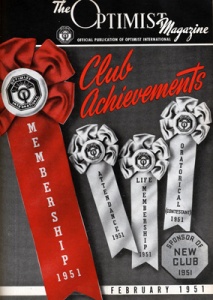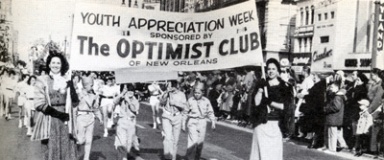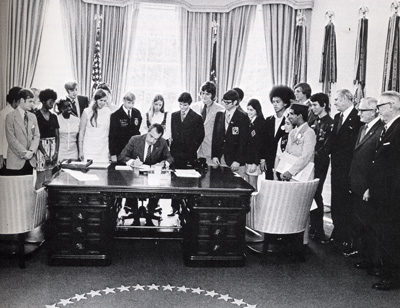The 1950s
As Optimists returned from serving their country in World War II and exchanged uniforms for civilian clothes, Clubs turned from wartime projects to their own campaigns of enlarging and strengthening their organization by recruiting new members. From 1950 to 1960, Optimism spread at a rate never before seen in its history. While 700 Clubs and just over 38,000 members started the decade, the ten-year period ended with 1,871 Clubs consisting of over 73,000 members. Two significant creations occurred during the 1950s: club sponsorship of new Clubs and the awards program. The club sponsorship program in 1950, in which Optimists went out and built new Clubs themselves rather than leaving this work in the hands of paid organizers, transformed the organization. The building of nearly 1,200 Clubs during the first decade of this program nearly doubled what the paid field staff had been able to do in the first 30 years. The creation of what was originally known as the “Achievement and Awards Program” during the 1950-51 year helped recognize those individuals, Clubs, Zones and Districts for their efforts in growing the organization. While there was nothing revolutionary in the recognition of effort, the program did provide a new level of excellence toward which Optimists could work and a system by which they could measure their accomplishments. |
 As the 1950s begin, so does the awards program. |
| Youth Appreciation Week |
 |
 The creation of Youth Appreciation Week is reason to celebrate for Optimists and youth everywhere. |
On a bitter cold winter night in 1955 near the foothills of the Blue Ridge Mountains in North Carolina, Optimist T. Earl Yarborough and his wife were driving back home to Charlotte after assisting in the organization of a Junior Optimist Club in Morganton. Under normal conditions the drive would have required less than two hours. That night, however, an icy glaze stretched their trip to five hours and the Yarboroughs had ample time to talk and to reflect on the incidents of the evening. “It beats me,” said Earl. “On a night like this every one of those kids showed up for the meeting. Some of them had to walk several miles, I understand. They must be pretty good kids to be so enthusiastic over their new Junior Optimist Club.” Then, almost as an afterthought, he added, “I wonder what the morning papers will have to say about this. Nothing, in all probability, for it’s really not great news. If those boys had been arrested for swiping hubcaps or cutting tires or something though, there would have been a story about that.” It was a shame, the Yarboroughs agreed, that so much public attention is paid to teenagers who go wrong and so little to those who stay right. By the time he reached his home, Yarborough had the conviction that Optimists should and could do something about it. He armed himself with statistics on juvenile delinquency and on juvenile decency. He solicited the aid of two fellow Optimists, Harold Smoak and a Charlotte newspaperman, Kays Gary. He carried his idea for a Youth Appreciation Day to his own Optimist Club and to the North Carolina statehouse, where the governor of the state gave his enthusiastic endorsement. On May 22, 1955, North Carolina observed the first Youth Appreciation Day. |
The following year Optimist International scheduled a Youth Appreciation Week program on a pilot basis in five states and one Canadian province. Acceptance of the program and eager participation in it were reported from every trial area. In the autumn of 1957, Optimist International launched its first organization-wide program that had as its sole purpose the “recognition, commendation and encouragement of the 95 percent of all teenagers whose feet are firmly planted on the right track and from whose midst will come the adult leaders of tomorrow’s world.” More than a thousand Optimist Clubs held Youth Appreciation Week programs that first year. The number increased steadily and the program continues to be the most popular of all of Optimist International’s programs. |
 With his signature, U.S. President Richard M. Nixon makes official the first Youth Appreciation Week. |
| Youth Appreciation Week hit its high water mark in 1971 when the United States Congress by joint resolution passed Public Law 92-43. It designated the week beginning the following November 8 as Youth Appreciation Week. On November 5, 1971, in the Oval Office of the White House in Washington, D.C., U.S. President Richard M. Nixon signed the first Youth Appreciation Week proclamation in the presence of Immediate Past International President Charles C. Campbell, Optimist T. Earl Yarborough, sponsors of the bill in both Houses of Congress and 21 young people from 12 states. |